Time-Series Satellite Imagery Demonstrates the Progressive Failure of a City Master Plan to Control Urbanization in Abuja, Nigeria
Abstract
1. Introduction
2. Study Area
3. Research Data
3.1. Remotely Sensed Imagery
3.2. Urban Planning Data
3.3. Land Cover Reference Data
4. Methodology
4.1. Land Cover Classification System
4.2. Data Preprocessing
4.3. Image Classification
4.4. Comparison with Master Plan
5. Results
5.1. Land Cover Classification
5.2. Master Plan Comparison
6. Discussion
7. Conclusions
Supplementary Materials
Author Contributions
Funding
Acknowledgments
Conflicts of Interest
References
- Maktav, D.; Erbek, F.; Jürgens, C. Remote sensing of urban areas. Int. J. Remote Sens. 2005, 26, 655–659. [Google Scholar] [CrossRef]
- United Nations. World Urbanization Prospects: The 2018 Revision; (ST/ESA/SER.A/420); United Nations, Department of Economic and Social Affairs, Population Division: New York, NY, USA, 2019. [Google Scholar]
- United Nations. World Urbanization Prospects: The 2014 Revision; (ST/ESA/SER.A/366); United Nations, Department of Economic and Social Affairs: New York, NY, USA, 2015. [Google Scholar]
- Ji, C.; Liu, Q.; Sun, D.; Wang, S.; Lin, P.; Li, X. Monitoring urban expansion with remote sensing in China. Int. J. Remote Sens. 2001, 22, 1441–1455. [Google Scholar] [CrossRef]
- Borja, J.; Belil, M.; Castells, M.; Benner, C. Local and Global: The Management of Cities in the Information Age; United Nations Centre for Human Settlement, Earthscan: London, UK, 1997. [Google Scholar]
- Marshall, T. Urban Planning and Governance: Is there a Barcelona Model? Int. Plan. Stud. 2000, 5, 299–319. [Google Scholar] [CrossRef]
- Albrechts, L. In pursuit of new approaches to strategic spatial planning. A European perspective. Int. Plan. Stud. 2001, 6, 293–310. [Google Scholar] [CrossRef]
- Steinberg, F. Strategic urban planning in Latin America: Experiences of building and managing the future. Habitat Int. 2005, 29, 69–93. [Google Scholar] [CrossRef]
- Watson, V. The planned city sweeps the poor away…: Urban planning and 21st century urbanisation. Prog. Plann. 2009, 72, 151–193. [Google Scholar] [CrossRef]
- Ikejiofor, U. Planning and the political process: Sifting some underlying issues in the development of Abuja, Nigeria’s new capital. Third World Plann. Rev. 1997, 19, 271. [Google Scholar] [CrossRef]
- Abubakar, I.R. Abuja city profile. Cities 2014, 41, 81–91. [Google Scholar] [CrossRef]
- Vale, L. Architecture, Power and National Identity; Routledge: Oxford, UK, 2014. [Google Scholar]
- IPA (International Planning Associates). The Master Plan for Abuja the New Federal Capital of Nigeria; Federal Capital Development Authority (FCDA): Abuja, Nigeria, 1979.
- Myers, G.A. African Cities: Alternative Visions of Urban Theory and Practice; Zed Books Limited: London, UK, 2011. [Google Scholar]
- Iro, I. Demographic pressure and the application of GIS in land reforms: The case of restoration of Abuja master plan and sanitization of cadastral and land registry. In Proceedings of the Map Middle East Conference on GIS Development, Dubai Municipality, UAE, 9–11 April 2007. [Google Scholar]
- NPC. Nigeria Population Census; National Bureau of Statistics: Abuja, Nigeria, 2006.
- Longley, P.A. Geographical information systems: Will developments in urban remote sensing and GIS lead to ‘better’ urban geography? Prog. Hum. Geogr. 2002, 26, 231–239. [Google Scholar] [CrossRef]
- Aplin, P. Comparison of simulated IKONOS and SPOT HRV imagery for classifying urban areas. In Remotely Sensed Cities; Mesev, V., Ed.; Taylor & Francis: London, UK, 2003; pp. 23–45. [Google Scholar]
- Blaschke, T.; Hay, G.J.; Weng, Q.; Resch, B. Collective sensing: Integrating geospatial technologies to understand urban systems—An overview. Remote Sens. 2011, 3, 1743–1776. [Google Scholar] [CrossRef]
- Aplin, P. Remote sensing: Base mapping. Prog. Phys. Geog. 2003, 27, 275–283. [Google Scholar] [CrossRef]
- Weng, Q. Remote sensing of impervious surfaces in the urban areas: Requirements, methods, and trends. Remote Sens. Environ. 2012, 117, 34–49. [Google Scholar] [CrossRef]
- Wania, A.; Kemper, T.; Tiede, D.; Zeil, P. Mapping recent built-up area changes in the city of Harare with high resolution satellite imagery. Appl. Geogr. 2014, 46, 35–44. [Google Scholar] [CrossRef]
- Huang, B.; Zhao, B.; Song, Y. Urban land-use mapping using a deep convolutional neural network with high spatial resolution multispectral remote sensing imagery. Remote Sens. Environ. 2018, 214, 73–86. [Google Scholar] [CrossRef]
- Fenta, A.A.; Yasuda, H.; Haregeweyn, N.; Belay, A.S.; Hadush, Z.; Gebremedhin, M.A.; Mekonnen, G. The dynamics of urban expansion and land use/land cover changes using remote sensing and spatial metrics: The case of Mekelle City of northern Ethiopia. Int. J. Remote Sens. 2017, 38, 4107–4129. [Google Scholar] [CrossRef]
- Kpienbaareh, D.; Luginaah, I. Modelling the internal structure, dynamics and trends of urban sprawl in Ghanaian cities using remote sensing, spatial metrics and spatial analysis. Afr. Geogr. Rev. 2019. [Google Scholar] [CrossRef]
- Al Rifat, S.A.; Liu, W. Quantifying spatiotemporal patterns and major explanatory factors of urban expansion in Miami Metropolitan Area during 1992–2016. Remote Sens. 2019, 11, 2493. [Google Scholar] [CrossRef]
- Hu, T.; Yang, J.; Li, X.; Gong, P. Mapping urban land use by using Landsat images and open social data. Remote Sens. 2016, 8, 151. [Google Scholar] [CrossRef]
- Liu, X.; He, J.; Yao, Y.; Zhang, J.; Liang, H.; Wang, H.; Hong, Y. Classifying urban land use by integrating remote sensing and social media data. Int. J. Geogr. Inf. Sci. 2017, 31, 1675–1696. [Google Scholar] [CrossRef]
- Martellozzo, F.; Amato, F.; Murgante, B.; Clarke, K. Modelling the impact of urban growth on agriculture and natural land in Italy to 2030. Appl. Geogr. 2018, 91, 156–167. [Google Scholar] [CrossRef]
- Ramankutty, N.; Coomes, O.T. Land-use regime shifts: An analytical framework and agenda for future land-use research. Ecol. Soc. 2016, 21(2). [Google Scholar] [CrossRef]
- Foley, J.A.; Defries, R.; Asner, G.P.; Barford, C.; Bonan, G.; Carpenter, S.R.; Chapin, F.S.; Coe, M.T.; Daily, G.C.; Gibbs, H.K.; et al. Global consequences of land use. Science 2005, 309, 570–574. [Google Scholar] [CrossRef]
- Laurian, L.; Day, M.; Backhurst, M.; Berke, P.; Ericksen, N.; Crawford, J.; Chapman, S. What drives plan implementation? plans, planning agencies and developers. J. Environ. Plann. Man. 2004, 47, 555–577. [Google Scholar] [CrossRef]
- Maria, S.I.; Imran, M. Planning of Islamabad and Rawalpindi: What went wrong? In Proceedings of the 42nd ISoCaRP Congress, Istanbul, Turkey, 14–18 September 2006; p. 4. [Google Scholar]
- Beauregard, R.A.; Marpillero-Colomina, A. More than a master plan: Amman 2025. Cities 2011, 28, 62–69. [Google Scholar] [CrossRef]
- Feitelson, E.; Felsenstein, D.; Razin, E.; Stern, E. Assessing land use plan implementation: Bridging the performance-conformance divide. Land Use Policy 2017, 61, 251–264. [Google Scholar] [CrossRef]
- Tian, L.; Shen, T. Evaluation of plan implementation in the transitional China: A case of Guangzhou city master plan. Cities 2011, 28, 11–27. [Google Scholar] [CrossRef]
- Dutta, V. Land use dynamics and peri-urban growth characteristics: Reflections on master plan and urban suitability from a sprawling north Indian city. Environ. Urban. Asia 2012, 3, 277–301. [Google Scholar] [CrossRef]
- Qian, Z. Master plan, plan adjustment and urban development reality under China’s market transition: A case study of Nanjing. Cities 2013, 30, 77–88. [Google Scholar] [CrossRef]
- Padeiro, M. Conformance in land-use planning: The determinants of decision, conversion and transgression. Land Use Policy 2016, 55, 285–299. [Google Scholar] [CrossRef]
- Ujoh, F.; Kwabe, I.D.; Ifatimehin, O.O. Understanding urban sprawl in the federal capital city, Abuja: Towards sustainable urbanization in Nigeria. J. Geogr. Reg. Plann. 2010, 3, 106–113. [Google Scholar]
- Ujoh, F.M.; Kwabe, I.D.; Ifatimehin, O.O. Urban expansion and vegetal cover loss in and around Nigeria’s federal capital city. J. Ecol. Nat. Environ. 2011, 3, 1–10. [Google Scholar]
- Zubair, O.A.; Ojigi, L.M.; Mbih, R.A. Urbanization: A catalyst for the emergence of squatter settlements and squalor in the vicinities of the federal capital city of Nigeria. J. Sustain. Dev. 2015, 8, 134. [Google Scholar] [CrossRef]
- Idoko, M.A.; Bisong, F.E. Application of geo-information for evaluation of land use change: A case study of federal capital territory-Abuja. Environ. Res. J. 2010, 4, 140–144. [Google Scholar] [CrossRef]
- Moore, J. The political history of Nigeria’s new capital. J. Mod. Afr. Stud. 1984, 22, 167–175. [Google Scholar] [CrossRef]
- Ikejiofor, U. Access to land, development control and low-income housing in Abuja, Nigeria: Policy, politics and bureaucracy. Plann. Pract. Res. 1998, 13, 299–309. [Google Scholar] [CrossRef]
- Adama, O. Governing from Above: Solid Waste Management in Nigeria’s New Capital City of Abuja; Universitetsservice US-AB: Stockholm, Sweden, 2007. [Google Scholar]
- O’Regan, H.J.; Wilkinson, D.M.; Marston, C.G. Hominin home ranges and habitat variability: Exploring modern African analogues using remote sensing. J. Archaeol. Sci. Rep. 2016, 9, 238–248. [Google Scholar] [CrossRef]
- Marston, C.G.; Giraudoux, P. On the synergistic use of optical and SAR time-series satellite data for small mammal disease host mapping. Remote Sens. 2019, 11, 39. [Google Scholar] [CrossRef]
- Jianchu, X.; Fox, J.; Vogler, J.B.; Yongshou, Z.P.F.; Lixin, Y.; Jie, Q.; Leisz, S. Land-use and land-cover change and farmer vulnerability in xishuangbanna prefecture in southwestern China. Environ. Manag. 2005, 36, 404–413. [Google Scholar] [CrossRef]
- Weber, C.; Petropoulou, C.; Hirsch, J. Urban development in the Athens metropolitan area using remote sensing data with supervised analysis and GIS. Int. J. Remote Sens. 2005, 26, 785–796. [Google Scholar] [CrossRef]
- Small, C. High spatial resolution spectral mixture analysis of urban reflectance. Remote Sens. Environ. 2003, 88, 170–186. [Google Scholar] [CrossRef]
- Small, C.; Pozzi, F.; Elvidge, C.D. Spatial analysis of global urban extent from DMSP-OLS night lights. Remote Sens. Environ. 2005, 96, 277–291. [Google Scholar] [CrossRef]
- Taubenböck, H.; Esch, T.; Felbier, A.; Wiesner, M.; Roth, A.; Dech, S. Monitoring urbanization in mega cities from space. Remote Sens. Environ. 2012, 117, 162–176. [Google Scholar] [CrossRef]
- Momeni, R.; Aplin, P.; Boyd, D.S. Mapping complex urban land cover from spaceborne imagery: The influence of spatial resolution, spectral band set and classification approach. Remote Sens. 2016, 8, 88. [Google Scholar] [CrossRef]
- Anderson, J.R. A Land Use and Land Cover Classification System for Use with Remote Sensor Data; US Government Printing Office: Washington, DC, USA, 1976.
- Foody, G.M. Status of land cover classification accuracy assessment. Remote Sens. Environ. 2002, 80, 185–201. [Google Scholar] [CrossRef]
- Aplin, P. On scales and dynamics in observing the environment. Int. J. Remote Sens. 2006, 27, 2123–2140. [Google Scholar] [CrossRef]
- Chen, X.; Chen, J.; Shi, Y.; Yamaguchi, Y. An automated approach for updating land cover maps based on integrated change detection and classification methods. ISPRS J. Photogramm. Remote Sens. 2012, 71, 86–95. [Google Scholar] [CrossRef]
- Hussain, M.; Chen, D.; Cheng, A.; Wei, H.; Stanley, D. Change detection from remotely sensed images: From pixel-based to object-based approaches. ISPRS J. Photogramm. Remote Sens. 2013, 80, 91–106. [Google Scholar] [CrossRef]
- Tewkesbury, A.P.; Comber, A.J.; Tate, N.J.; Lamb, A.; Fisher, P.F. A critical synthesis of remotely sensed optical image change detection techniques. Remote Sens. Environ. 2015, 160, 1–14. [Google Scholar] [CrossRef]
- Zeng, C.; Shen, H.; Zhang, L. Recovering missing pixels for Landsat ETM SLC-off imagery using multi-temporal regression analysis and a regularization method. Remote Sens. Environ. 2013, 131, 182–194. [Google Scholar] [CrossRef]
- Foody, G.M.; Campbell, N.; Trodd, N.; Wood, T. Derivation and applications of probabilistic measures of class membership from the maximum-likelihood classification. Photogramm. Eng. Remote Sens. 1992, 58, 1335–1341. [Google Scholar]
- Erbek, F.S.; Özkan, C.; Taberner, M. Comparison of maximum likelihood classification method with supervised artificial neural network algorithms for land use activities. Int. J. Remote Sens. 2004, 25, 1733–1748. [Google Scholar] [CrossRef]
- Otukei, J.R.; Blaschke, T. Land cover change assessment using decision trees, support vector machines and maximum likelihood classification algorithms. Int. J. Appl. Earth Obs. Geoinf. 2010, 12, S27–S31. [Google Scholar] [CrossRef]
- Srivastava, P.K.; Han, D.; Rico-Ramirez, M.A.; Bray, M.; Islam, T. Selection of classification techniques for land use/land cover change investigation. Adv. Space Res. 2012, 50, 1250–1265. [Google Scholar] [CrossRef]
- Li, C.; Wang, J.; Wang, L.; Hu, L.; Gong, P. Comparison of classification algorithms and training sample sizes in urban land classification with Landsat thematic mapper imagery. Remote Sens. 2014, 6, 964–983. [Google Scholar] [CrossRef]
- Perumal, K.; Bhaskaran, R. Supervised classification performance of multispectral images. J. Comput. 2010, 2, 126–129. [Google Scholar]
- Fichera, C.R.; Modica, G.; Pollino, M. Land cover classification and change-detection analysis using multi-temporal remote sensed imagery and landscape metrics. Eur. J. Remote Sens. 2012, 45, 1–18. [Google Scholar] [CrossRef]
- Jia, K.; Liang, S.; Zhang, N.; Wei, X.; Gu, X.; Zhao, X.; Yao, Y.; Xie, X. Land cover classification of finer resolution remote sensing data integrating temporal features from time series coarser resolution data. ISPRS J. Photogramm. Remote Sens. 2014, 93, 49–55. [Google Scholar] [CrossRef]
- Chen, D.; Stow, D. The effect of training strategies on supervised classification at different spatial resolutions. Photogramm. Eng. Remote Sens. 2002, 68, 1155–1162. [Google Scholar]
- Gong, P.; Howarth, P. An assessment of some factors influencing multispectral land-cover classification. Photogramm. Eng. Remote Sens. 1990, 56, 597–603. [Google Scholar]
- Liu, Y.; Wang, Y.; Peng, J.; Du, Y.; Liu, X.; Li, S.; Zhang, D. Correlations between urbanization and vegetation degradation across the world’s metropolises using DMSP/OLS nighttime light data. Remote Sens. 2015, 7, 2067–2088. [Google Scholar] [CrossRef]
- Yuan, F.; Sawaya, K.E.; Loeffelholz, B.C.; Bauer, M.E. Land cover classification and change analysis of the twin cities (Minnesota) metropolitan area by multi-temporal Landsat remote sensing. Remote Sens. Environ. 2005, 98, 317–328. [Google Scholar] [CrossRef]
- Rizzo, A. Rapid urban development and national master planning in Arab gulf countries. Qatar as a case study. Cities 2014, 39, 50–57. [Google Scholar] [CrossRef]
- Saglie, I.; Sandberg, S.V.L. Urban expansion in Norway-development by plan? Scand. Hous. Plan. Res. 1997, 14, 51–70. [Google Scholar] [CrossRef]
- Amba, K. The need for popular participation in Abuja: A Nigerian story of informal settlements. J. Place Manag. Dev. 2010, 3, 149–159. [Google Scholar] [CrossRef]
- COHRE. The Myth of the Abuja Master Plan: Forced Evictions as Urban. Planning in Abuja; Centre for Housing Right and Evictions: Geneva, Switzerland, 2008. [Google Scholar]
- Jibril, I. Squatter resettlement/relocation programme in Abuja, Nigeria and the issue of land title security. In Proceedings of the FIG Working Week, Eilat, Israel, 3–8 May 2009. [Google Scholar]
- Morah, E.U. Housing in Nigeria’s new capital at Abuja: Achievements and problems. In UBC Planning Papers: Comparative Urban & Regional Studies, (CS 23); University of British Columbia: Vancouver, BC, Canada, 1990. [Google Scholar]
- Mabogunje, A. Abuja; the Promise, the Performance and the Prospects. The Review of Abuja Master Plan; Fountain Publications: Ibadan, Nigeria, 2001. [Google Scholar]
- Ebehikalu, N.O.; Dawam, P.D.; Kasim, U. A study of the state of infrastructure in the Federal Capital Territory, Abuja. J. Resour. Develop. Manag. 2016, 18, 26–31. [Google Scholar]
- Friedmann, J. Globalization and the emerging culture of planning. Prog. Plann. 2005, 64, 183–234. [Google Scholar] [CrossRef]
- Imam, A.; Mohammed, B.; Wilson, D.C.; Cheeseman, C.R. Solid waste management in Abuja, Nigeria. Waste Manag. 2008, 28, 468–472. [Google Scholar] [CrossRef]
- Ikoku, G. The city as public space: Abuja-the capital city of Nigeria. FORUM 2004, 6, 34–41. [Google Scholar]
- Space for Change. Abuja Land Swap Initiative: The Challenges Within. Available online: https://spacesforchange.org/abuja-land-swap-initiative-the-challenges-within/ (accessed on 23 December 2019).
- Gusah, S. Community land trusts: A model for integrating Abuja’s urban villages within the city master plan. In CHANGING CITIES: Climate, Youth, and Land Market in Urban Areas; Herzer, L.E., Ed.; Wilson Center: Washington, DC, USA, 2012; pp. 141–159. [Google Scholar]
- Kalgo, M.; Ayileka, O. The review of Abuja master plan. In Proceedings of the International Workshop for the Review of Abuja Master Plan, Abuja, Nigeria, 29 November–2 December 2001. [Google Scholar]
- Olujimi, J. Evolving a planning strategy for managing urban sprawl in Nigeria. J. Hum. Ecol. 2009, 25, 201–208. [Google Scholar] [CrossRef]
- Premium Times. Land swap policy will address resettlement of Abuja indigenes—FCTA. Available online: http://www.premiumtimesng.com/regional/173558-land-swap-policy-will-address-%E2%80%8Bre%E2%80%8Bsettlement-abuja-indigenes-fcta.html/ (accessed on 23 December 2019).
- Hameed, R.; Nadeem, O. Challenges of implementing urban master plans: The Lahore experience. Proc. World Acad. Sci. Eng. Technol. 2006, 17, 335–342. [Google Scholar]
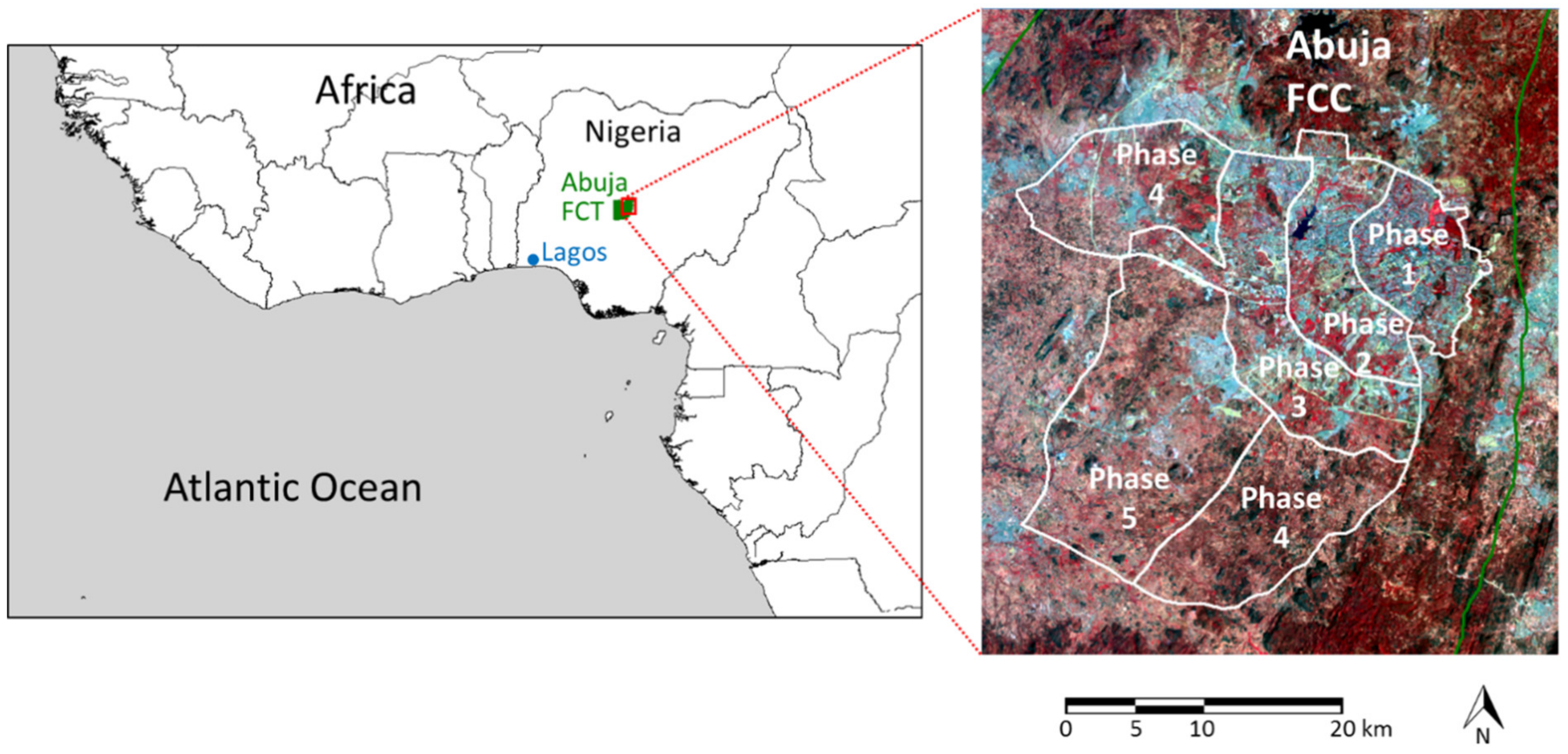
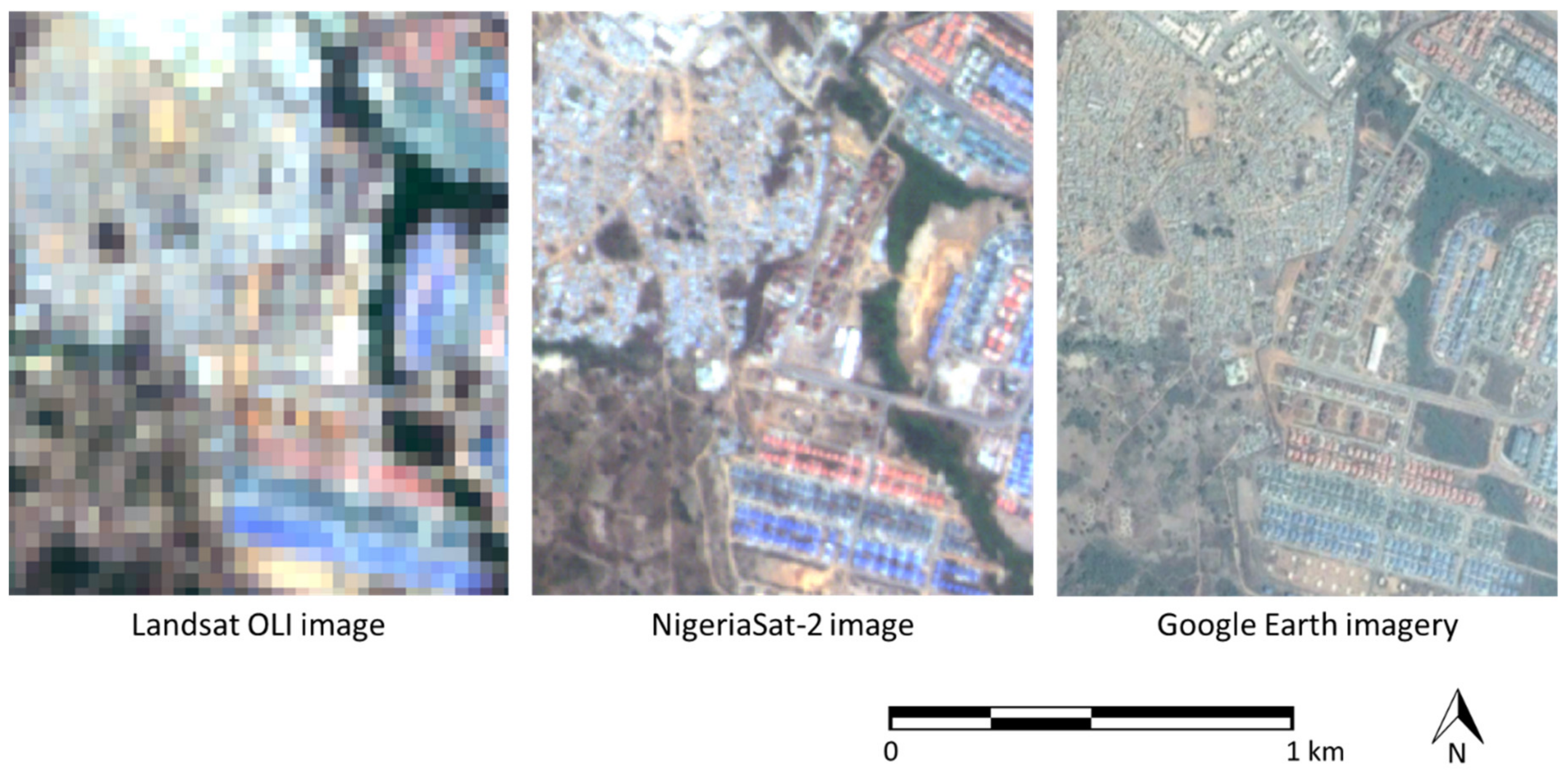
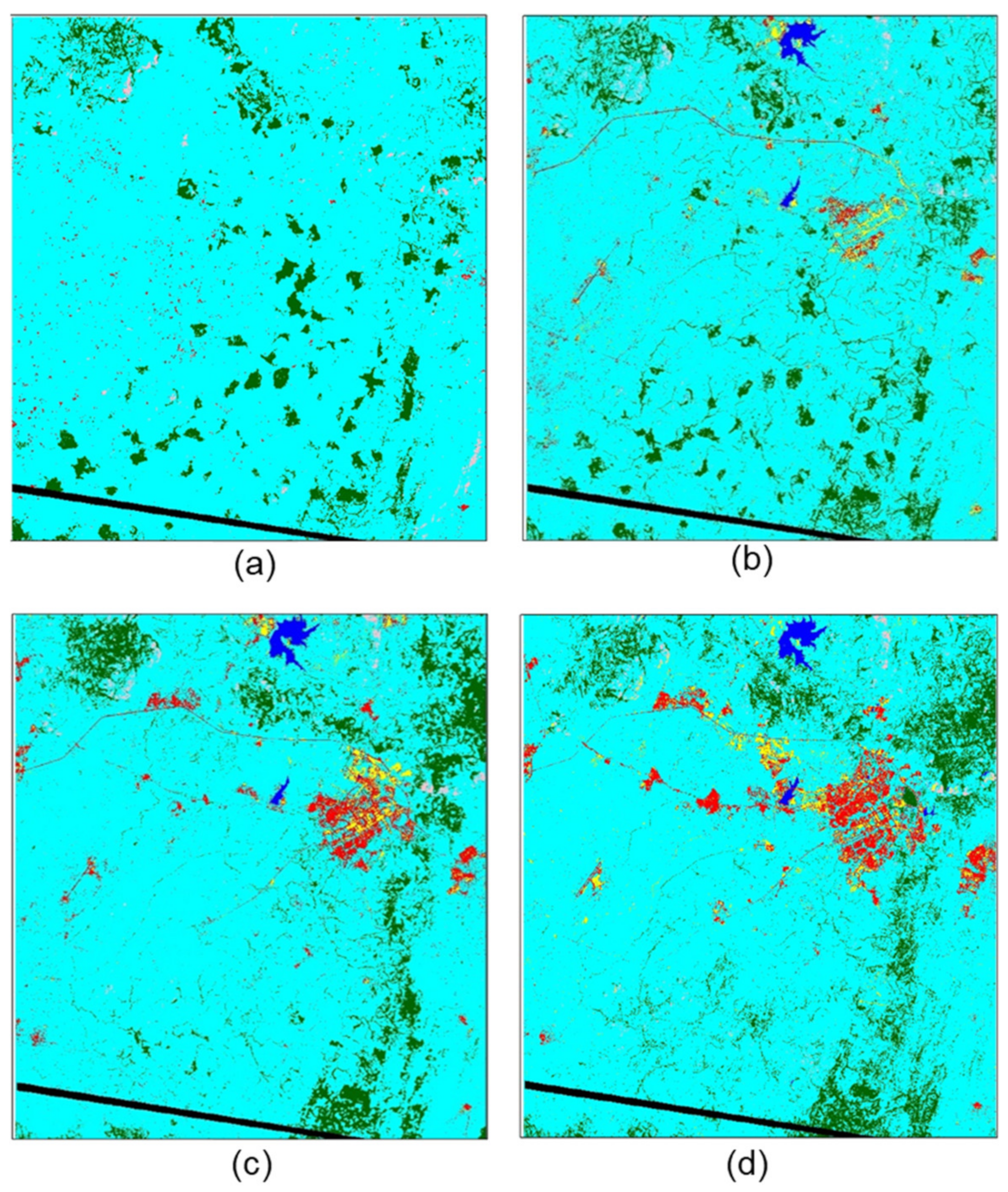
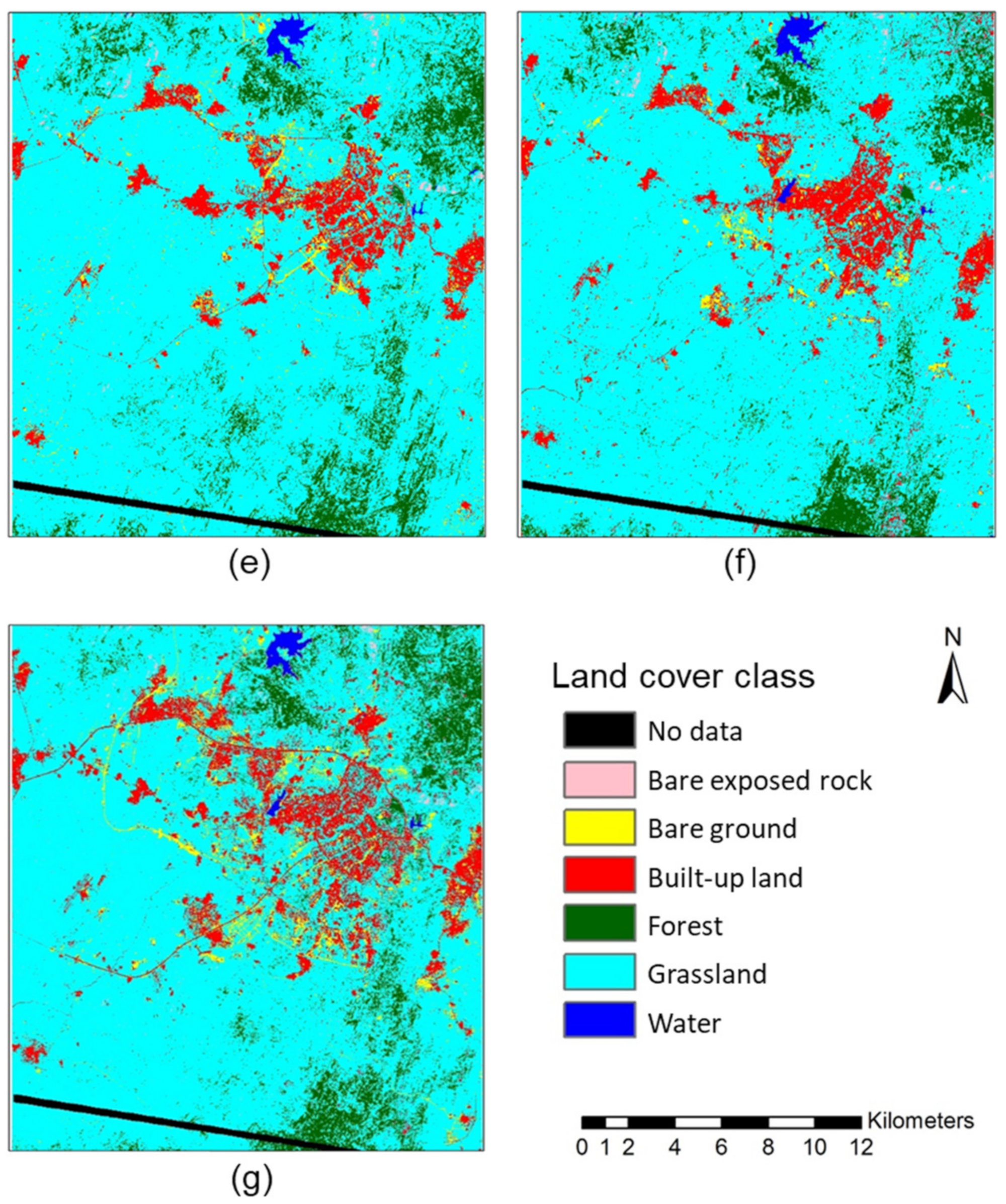
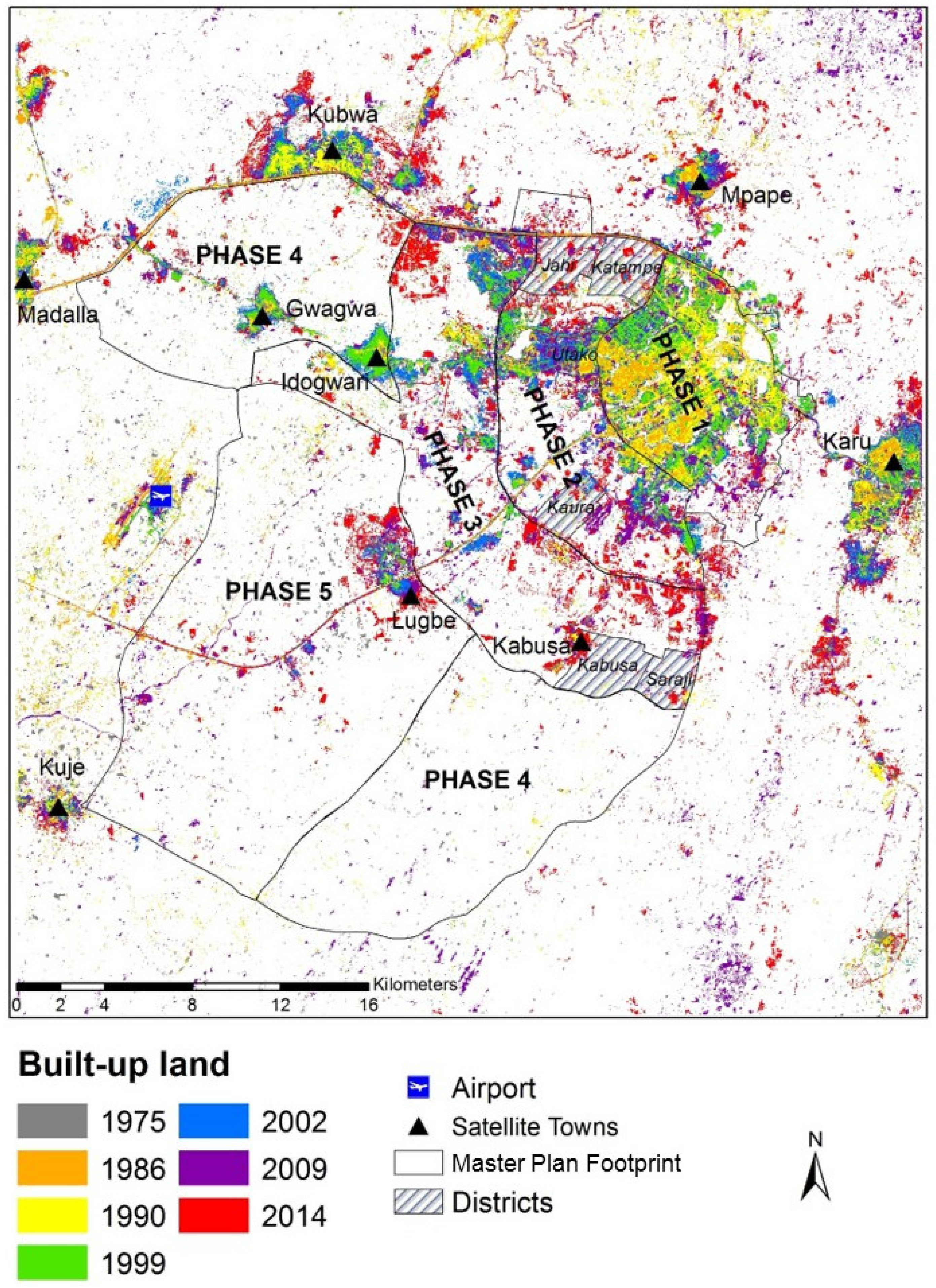
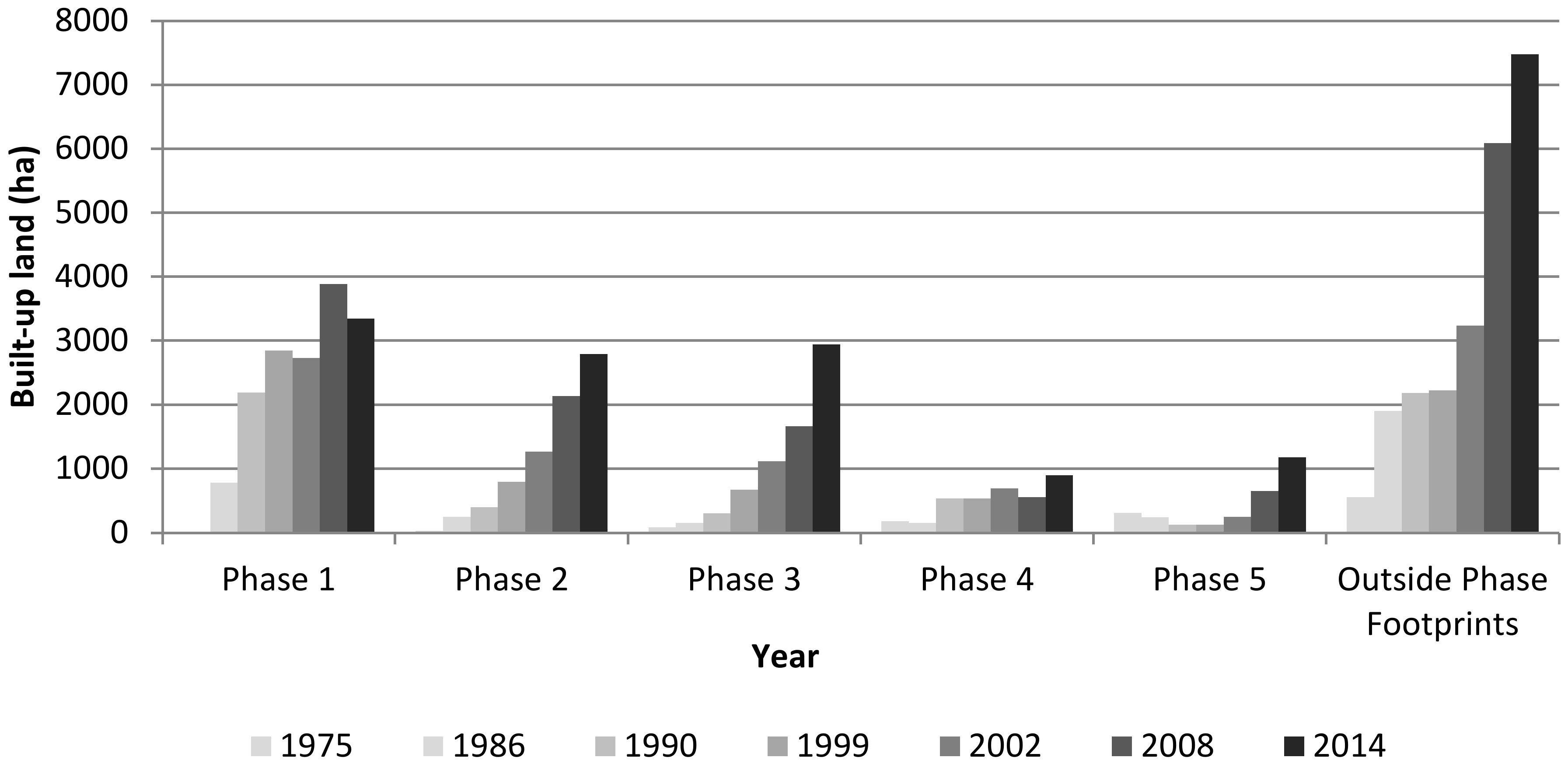
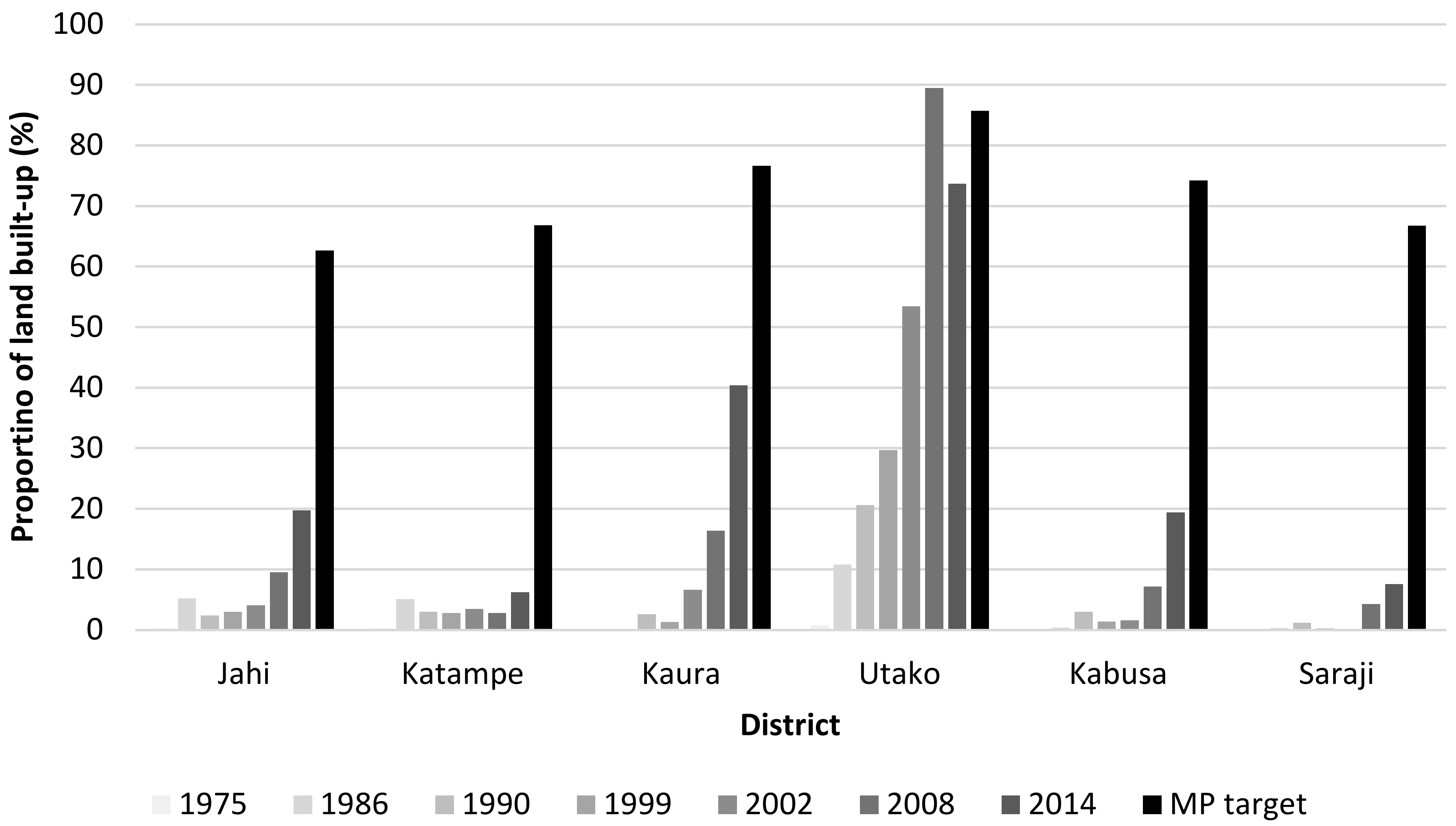
| Acquisition Date | Sensor | Spatial Resolution (m) | Spectral Bands Used (μm) |
|---|---|---|---|
| 6 Dec 1975 | Landsat MSS | 60 * | G (0.5–0.6), R (0.6–0.7), NIR 1 (0.7–0.8), NIR 2 (0.8–1.1) |
| 8 Jan 1986 | Landsat TM | 30 | B (0.45–0.52), G (0.52–0.60), R (0.63–0.69), NIR (0.76–0.90), SWIR 1 (1.55–1.75), SWIR 2 (2.08–2.35) |
| 12 Feb 1990 | Landsat TM | 30 | B (0.45–0.52), G (0.52–0.60), R (0.63–0.69), NIR (0.76–0.90), SWIR 1 (1.55–1.75), SWIR 2 (2.08–2.35) |
| 28 Jan 1999 | Landsat TM | 30 | B (0.45–0.52), G (0.52–0.60), R (0.63–0.69), NIR (0.76–0.90), SWIR 1 (1.55–1.75), SWIR 2 (2.08–2.35) |
| 2 Dec 2002 | Landsat ETM+ | 30 | B (0.45–0.52), G (0.52–0.60), R (0.63–0.69), NIR (0.77–0.90), SWIR 1 (1.55–1.75), SWIR 2 (2.09–2.35) |
| 29 Jan 2008 | Landsat ETM+ | 30 | B (0.45–0.52), G (0.52–0.60), R (0.63–0.69), NIR (0.77–0.90), SWIR 1 (1.55–1.75), SWIR 2 (2.09–2.35) |
| 21 Jan 2014 | Landsat OLI | 30 | B (0.45–0.51), G (0.53–0.59), R (0.64–0.67), NIR (0.85–0.88), SWIR 1 (1.57–1.65), SWIR 2 (2.11–2.29) |
| 15 Jan 2014 | NigeriaSat-2 | 5 m and 2.5 m (P) | B (0.45–0.52), G (0.52–0.60), R (0.63–0.69), NIR (0.76–0.90), P (0.45–0.90) |
| Land Cover Class | Description |
|---|---|
| Bare exposed rock | Bare rock outcrops, including occasional rounded knolls, inselbergs, granitic and other exposed rock outcrops. |
| Bare ground | Open areas devoid of trees, grass or other vegetation that is not built-up, water or exposed rock. This class often comprises land cleared for development. |
| Built-up land | Impervious surfaces, including building rooftops, asphalt roads and concrete surfaces. |
| Forest | Woodlands and thick riverine vegetation. This class generally comprises patches of forest in isolated areas with steep slopes in riverine areas. |
| Grassland | Areas dominated by grasses but also including shrubs and isolated trees (i.e., not forest blocks) and any other vegetation. |
| Water | Water bodies such as reservoirs, rivers and standing water. |
| Land Cover Class | 1975 | 1986 | 1990 | 1999 | 2002 | 2008 | 2014 | |||||||
|---|---|---|---|---|---|---|---|---|---|---|---|---|---|---|
| Area (ha) | Study Area % | Area (ha) | Study Area % | Area (ha) | Study Area % | Area (ha) | Study Area % | Area (ha) | Study Area % | Area (ha) | Study Area % | Area (ha) | Study Area % | |
| Bare exposed rock | 1327.3 | 0.7 | 1357.1 | 0.7 | 1167.6 | 0.6 | 1208.3 | 0.6 | 880.7 | 0.5 | 734.8 | 0.4 | 815.5 | 0.4 |
| Bare ground | 0.0 | 0.0 | 1949.4 | 1.0 | 1643.0 | 0.9 | 3143.5 | 1.7 | 3851.5 | 2.0 | 2309.2 | 1.2 | 6485.8 | 3.4 |
| Built-up land | 1166.8 | 0.6 | 3479.0 | 1.8 | 5721.3 | 3.0 | 7184.5 | 3.8 | 12,083.8 | 6.3 | 15,478.4 | 8.1 | 18,623.3 | 9.8 |
| Forest | 14,501.2 | 7.6 | 18,421.9 | 9.7 | 19,272.0 | 10.1 | 19,926.7 | 10.5 | 19,144.8 | 10.0 | 15,348.5 | 8.1 | 17,776.5 | 9.3 |
| Grassland | 173,154.6 | 91.1 | 164,623.5 | 86.3 | 161,777.0 | 84.9 | 158,013.1 | 82.9 | 153,614.5 | 80.6 | 155,599.2 | 81.7 | 145,962.9 | 76.5 |
| Water | 0.0 | 0.0 | 822.0 | 0.4 | 933.3 | 0.5 | 1038.1 | 0.5 | 938.4 | 0.5 | 1044.1 | 0.5 | 1038.1 | 0.5 |
© 2020 by the authors. Licensee MDPI, Basel, Switzerland. This article is an open access article distributed under the terms and conditions of the Creative Commons Attribution (CC BY) license (http://creativecommons.org/licenses/by/4.0/).
Share and Cite
Gumel, I.A.; Aplin, P.; Marston, C.G.; Morley, J. Time-Series Satellite Imagery Demonstrates the Progressive Failure of a City Master Plan to Control Urbanization in Abuja, Nigeria. Remote Sens. 2020, 12, 1112. https://doi.org/10.3390/rs12071112
Gumel IA, Aplin P, Marston CG, Morley J. Time-Series Satellite Imagery Demonstrates the Progressive Failure of a City Master Plan to Control Urbanization in Abuja, Nigeria. Remote Sensing. 2020; 12(7):1112. https://doi.org/10.3390/rs12071112
Chicago/Turabian StyleGumel, Ibrahim A., Paul Aplin, Christopher G. Marston, and Jeremy Morley. 2020. "Time-Series Satellite Imagery Demonstrates the Progressive Failure of a City Master Plan to Control Urbanization in Abuja, Nigeria" Remote Sensing 12, no. 7: 1112. https://doi.org/10.3390/rs12071112
APA StyleGumel, I. A., Aplin, P., Marston, C. G., & Morley, J. (2020). Time-Series Satellite Imagery Demonstrates the Progressive Failure of a City Master Plan to Control Urbanization in Abuja, Nigeria. Remote Sensing, 12(7), 1112. https://doi.org/10.3390/rs12071112







